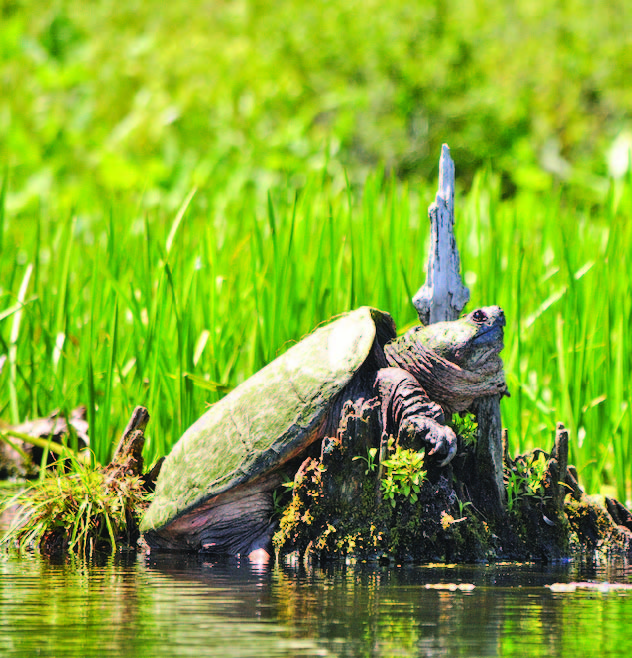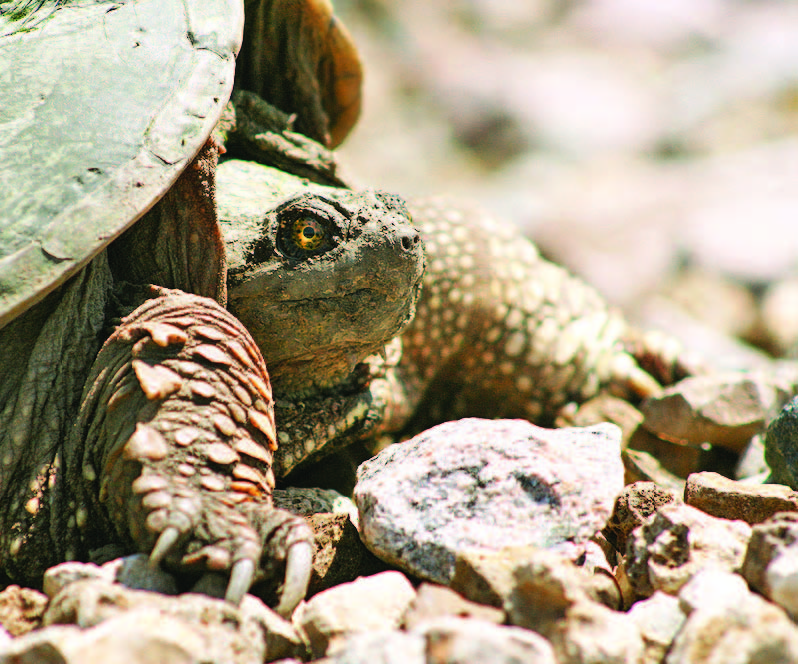In a Snap
You might have seen the hilarious story of Frank the Snapping Turtle on the internet, an expletive-laced narrative about how two humans saved an entire town from Frank, a cantankerous, hissing, 40-pound fury, by lassoing him around his waist and returning him to his natural habitat against his continuing protests, according to meme website Cheezburger.com.
Frank is a wonderful example of the common snapping turtle (Chelydra serpentinea), a large freshwater turtle whose natural range extends from southeastern Canada to Florida, according to Creature Control. They have a keeled carapace that is brown, black, or olive, and their cross-shaped plastron is much smaller compare to other turtles, which leaves their limbs and sides of their body exposed. This means that snapping turtles are quite a comical sight, with a shell that seems a little too small for them sitting on their leathery backs.
Big turtle in a small pond
Snapping turtles are one of the most familiar reptiles in Northern America and are the largest freshwater turtles in Canada. Most North Americans are familiar with the sight of this grumpy shield-bearer crossing the road, swimming across a pond, or catching some rays perched up on a rock.

Like all turtles, snapping turtles are slow on land, but they are remarkable animals for many reasons. Their powerful snapping jaws and persistence make them superior hunters, and they can travel long distances in search of food or nesting sites.
Unfortunately, this wide-ranging search for food often puts the snapping turtle in conflict with humans, just as we saw with Frank. They will often invade residential ponds, which sometimes makes them trouble for the people who live there.
Tank invasion
In their quest for food and nesting sites, snapping turtles will choose to invade small garden ponds and larger game ponds stocked with fish. If they get into a fish pond, they can deplete the fish population quickly!
Humans who find themselves interacting with snapping turtles need to keep in mind their potential to bite and scratch. Snapping turtles are usually not aggressive when encountered in the water, perhaps because they feel more in their element.

On land, however, they tend to become belligerent, and will hiss when they feel threatened, as Frank did when the two brave humans who saved him approached.
Too big for his britches
There is a good reason for the snapping turtle’s nasty attitude – as we mentioned, snappers have an unusually small plastron for their size, and this makes them too big to hide inside their own shell!
They make up for this with sharp claws, the powerful bite for which they are famous, and an aggressive outlook toward life in general.
Never, ever pick up a snapping turtle! They have extremely flexible necks that can reach all the way back to their hind legs to bite. They would have no trouble reaching around and biting the hands of the poor fool who picked them up.

Remember that snapping turtles are mighty hunters in their natural habitat, and are able to catch frogs, insects, worms, snakes, birds, and small mammals. They can even bite through the thick shells of other turtles!
Mad Science
Recently, an Idaho teacher was on the news for allegedly feeding a live puppy to a snapping turtle in front of his students at his school, based on a 2018 report by Matthew Diebel for USA Today. Robert Crosland, a science teacher from Preston, Idaho, allegedly fed a deformed puppy, who was about to die, to a snapping turtle while his students looked on.
While some, such as animal rights activist Jill Parish, who filed a police report against Crosland, has denounced the act as disgusting and sick, others did not share this opinion.

Este Hull, a 7th grade student at Preston Junior High, said that Crosland usually fed mice or birds to his menagerie of animals, which also includes snakes, and also said that she felt better that it was a dying puppy, not just a healthy one.
Parents vouched for Crosland, telling news reporters that he was the best science teacher at the school, and that feeding a deformed puppy who was going to die anyway was “very much circle-of-life.”
Regardless which side of the debate you might side with, we can all agree that messing with an angry snapping turtle is a dangerous proposition, indeed.
This appeared in Animal Scene magazine’s March 2019 issue.





